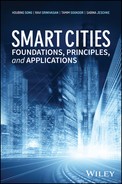Book Description
Provides the foundations and principles needed for addressing the various challenges of developing smart cities
Smart cities are emerging as a priority for research and development across the world. They open up significant opportunities in several areas, such as economic growth, health, wellness, energy efficiency, and transportation, to promote the sustainable development of cities. This book provides the basics of smart cities, and it examines the possible future trends of this technology. Smart Cities: Foundations, Principles, and Applications provides a systems science perspective in presenting the foundations and principles that span multiple disciplines for the development of smart cities.
Divided into three parts—foundations, principles, and applications—Smart Cities addresses the various challenges and opportunities of creating smart cities and all that they have to offer. It also covers smart city theory modeling and simulation, and examines case studies of existing smart cities from all around the world. In addition, the book:
- Addresses how to develop a smart city and how to present the state of the art and practice of them all over the world
- Focuses on the foundations and principles needed for advancing the science, engineering, and technology of smart cities—including system design, system verification, real-time control and adaptation, Internet of Things, and test beds
- Covers applications of smart cities as they relate to smart transportation/connected vehicle (CV) and Intelligent Transportation Systems (ITS) for improved mobility, safety, and environmental protection
Smart Cities: Foundations, Principles, and Applications is a welcome reference for the many researchers and professionals working on the development of smart cities and smart city-related industries.
